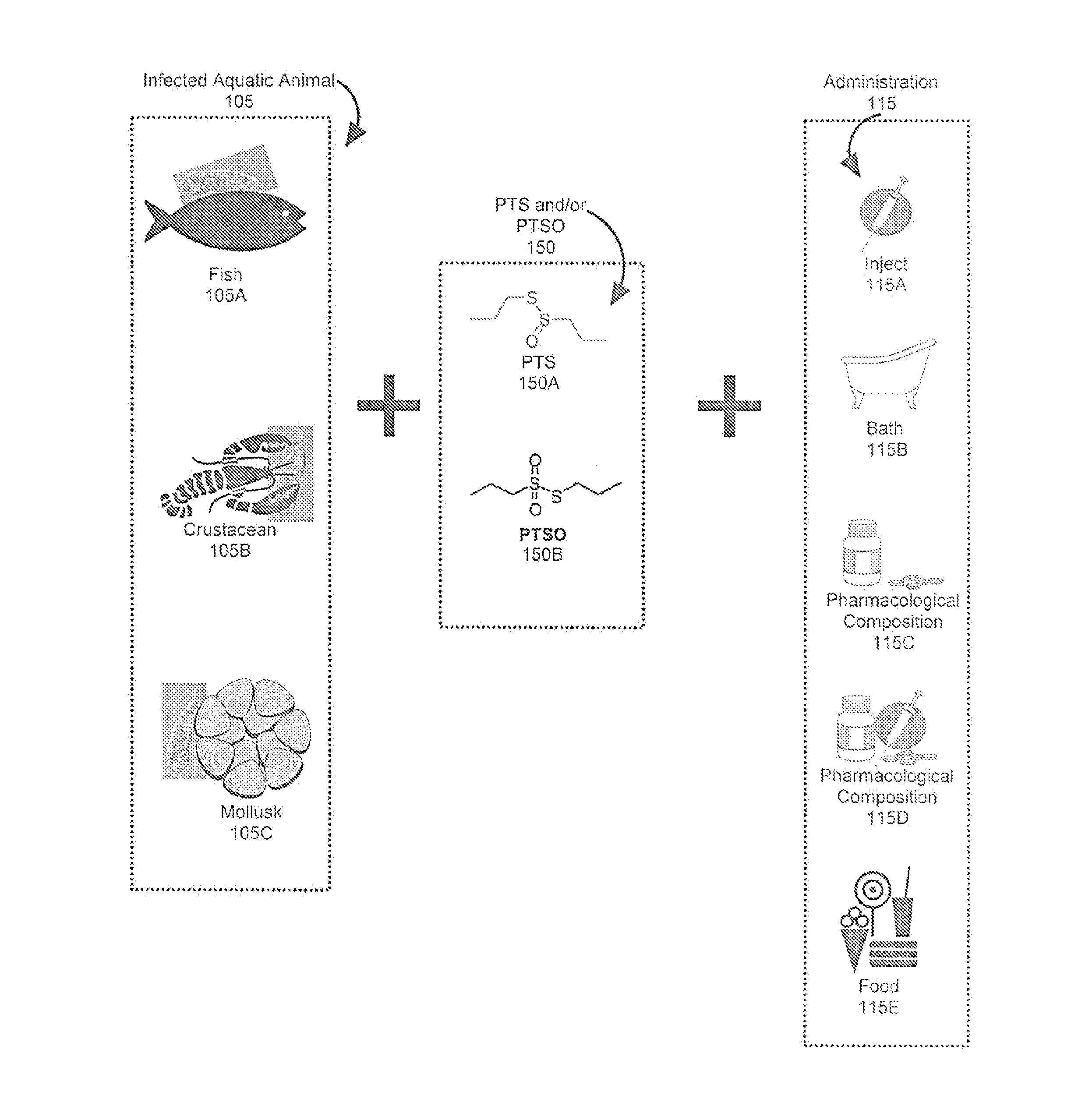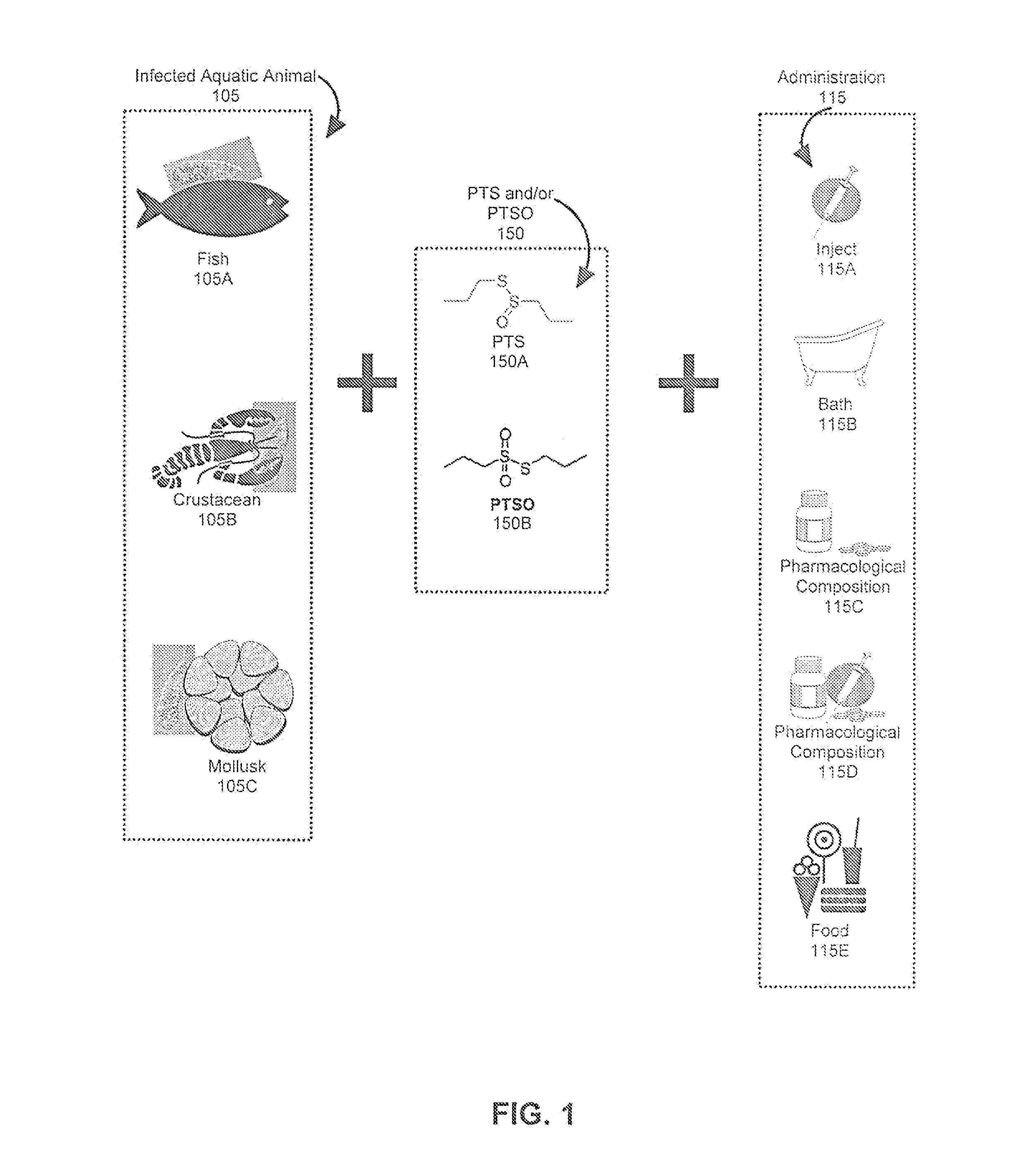Use of propyl propane thiosulfinate and propyl propane thiosulfonate for the prevention and reduction of parasites in aquatic animals
a technology of propyl propane thiosulfonate and propyl propane thiosulfonate, which is applied in the field of aquaculture, can solve the problems of high cost of conventional strategies for controlling parasites and resulting infections, and achieve the effect of reducing multiples
- Summary
- Abstract
- Description
- Claims
- Application Information
AI Technical Summary
Benefits of technology
Problems solved by technology
Method used
Image
Examples
example 1
[0037]The parasiticide efficacy of a mixture of propyl propane thiosulfinate (PTS) and propyl propane thiosulfonate (PTSO) was measured in vitro against Caligus rogercresseyi.
[0038]Upon receipt in the laboratory, the wild adult females and males were kept in filtered seawater (125 μm membranes) in absolute darkness inside a thermo-regulated chamber at 12° C. The egg sacs were removed gently from females using a fine-tipped forceps and placed in separate beakers with 500 mL of filtered seawater in the conditions described above until spawning. The fish were then separated into the different stages: Nauplius I, Nauplius II, Copepodite and Adult for subsequent in vitro susceptibility studies.
[0039]In order to evaluate effectiveness, several bioassays were performed in triplicate with different concentrations of propyl propane thiosulfinate (PTS) and propyl propane thiosulfonate (PTSO) at each stage: Nauplio I, Nauplio II, Copepodite and Adult. In total, 40 Caligus were used per test a...
example 2
[0040]In this example, a study of oral treatments of Ichthyobodosis in rainbow trout with different concentrations of Propyl propane thiosulphonate (PTSO) administered into feed was conducted.
[0041]Rainbow trout Oncornynchus mykiss were obtained from a local fish farm and acclimatized for at least 10 days before assay in 1001 tanks with aeration in closed systems of water (15±2° C., pH 7-7.5). The natural light-dark cycle was simulated (12 h light: 12 h dark). Fish were fed twice per day with a commercial feed (EFICO, Biomar, Spain). Parasite-free fish were experimentally infested by holding the parasite-free fish 25 days in a 100 l tank that also contained fish showing high-intensity infestation (20 uninfected fish to 10 infected fish). Twenty (20) fish were then sampled at random for determination of infestation intensity, which was determined to be a high intensity infestation in at least 50% of fish.
[0042]Fish were anaesthetized by immersion in bath with 100 ppm of Tricaine meth...
example 3
[0044]The objective of example 3 was to examine the activity of propyl propane thiosulphonate (PTSO) and propyl propane thiosulfinate (PTS) against L3 larvae of type I Anisakis and Hysterotylacium aduncum to explore the possible use of these compounds for prophylaxis treatments.
[0045]L3 of Anisakis type I and Hysterotylacium aduncum were collected by dissecting the fish Micromesistius poutassou (blue whiting) and Trachurus trachurus (mackerel) fished in the Cantabric sea, and selecting only larvae with a length greater than (>) 2.0 cm in the case of Anisakis, and greater than 0.8 cm for Hysterotylacium.
[0046]Larvae were axenised in antibiotic solution (Iglesias et al., 1997), introduced into polystyrene plate wells with 2 ml of sterile solution of 0.9% NaCl and the different concentrations of PTS alone, PTSO alone, and both PTS and PTSO (75, 200, 300 and 500 ppm) and then incubated at 36° C. in a 5% CO2 atmosphere. As controls, larvae were assayed without test compound under identi...
PUM
| Property | Measurement | Unit |
|---|---|---|
| concentration | aaaaa | aaaaa |
| densities | aaaaa | aaaaa |
| concentrations | aaaaa | aaaaa |
Abstract
Description
Claims
Application Information
 Login to View More
Login to View More - R&D
- Intellectual Property
- Life Sciences
- Materials
- Tech Scout
- Unparalleled Data Quality
- Higher Quality Content
- 60% Fewer Hallucinations
Browse by: Latest US Patents, China's latest patents, Technical Efficacy Thesaurus, Application Domain, Technology Topic, Popular Technical Reports.
© 2025 PatSnap. All rights reserved.Legal|Privacy policy|Modern Slavery Act Transparency Statement|Sitemap|About US| Contact US: help@patsnap.com



